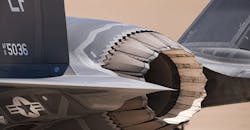Pratt & Whitney Draws $1.3 Billion for F135 Upgrade
Pratt & Whitney has drawn a U.S. Dept. of Defense contract valued at up to $1.3 billion for ongoing work on the F135 Engine Core Upgrade – the multi-year effort to advance the capabilities and durability of the F-35 Joint Strike Fighter propulsion system. According to a Pentagon announcement, the award covers “design, analysis, rig testing, engine test preparation, developmental hardware, test asset assembly, air system integration, airworthiness evaluation, and product support planning” in support of the continued development of the F135 engine.
The award consists of $88.4 million in U.S. Navy research funds, $88.4 million in U.S. Air Force research funds, and $39.4 million in F-35 program partners’ funds. The DoD indicated the work will be done mainly at Pratt & Whitney’s manufacturing center in East Hartford, Conn., and other locations in Connecticut, Florida, Indiana, Illinois, Maine, and Puerto Rico.
The funding covers Engine Core Upgrade activities through March 2028.
The Pratt & Whitney F135 is the power supply for all three variants of the F-35 Joint Strike Fighter jet, with over 1,200 engines supplied to date. As part of a broad (Block 4) upgrade to the aircraft’s electronic hardware and software, which will facilitate dozens of new weapons systems, the jets’ core processors and memory will be updated in an effort called Technology Refresh 3 (TR3.)
In preparation for the Block 4 upgrade, the ECU will build on the F-135’s 45,000-lb. thrust, thermal management, and integrated control systems, with “a modular approach to make way for newer hardware and software,” while maintaining the existing F135 supply chain and manufacturing network, supporting over 57,000 jobs and 225 suppliers businesses.
In July, Pratt & Whitney reported the ECU is on schedule and “exceeding expectations,” having completed its preliminary design review.
"This contract is critical to continuing our positive, forward momentum on this program," stated Jill Albertelli, president of Pratt & Whitney's Military Engines business. "It allows us to continue work in the risk-reduction phase with a fully staffed team focused on design maturation, aircraft integration, and mobilizing the supply base to prepare for production."
